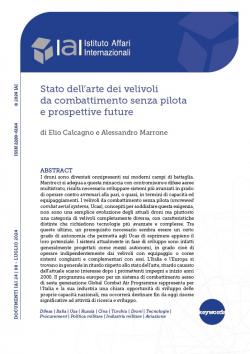Stato dell’arte dei velivoli da combattimento senza pilota e prospettive future
Aerial drones have become ubiquitous on modern battlefields. However, as countermeasures and multi-layered air defences catch up to the threat, a need arises for more advanced systems able to operate against well-equipped peer- or near-peer adversaries. Uncrewed combat aerial systems (UCAS), which are conceived to satisfy this requirement, are not merely an evolution of current drones but rather a different category of aerial vehicles altogether, with distinct characteristics requiring advanced and generally much costlier technologies. Among the latter, a degree of autonomous capabilities appears to be a necessary precondition for UCAS to fulfil their potential. Systems currently in development are generally designed either as “standalone” assets able to operate independently from crewed aircraft or as “adjunct” systems made to operate collaboratively with crewed assets. Italy and Europe in general are lagging behind the state of the art when it comes to UCAS due to scarce interest after initially exploring the field in the early 2000s. For Italy and its industry, the Global Combat Air Programme for a 6th-generation combat aircraft system represents a clear opportunity to develop UCAS capabilities, though significant resources must me directed at timely R&D activities.
This summary presents the main results of the study “Above and Beyond: State of the Art of Uncrewed Combat Aerial Systems and Future Perspectives”, edited by Elio Calcagno and Alessandro Marrone and published in Documenti IAI series.
-
Details
Rome, IAI, July 2024, 8 p. -
In:
-
Issue
24|08
Principali trend operativi nell’uso dei velivoli armati senza equipaggio
L’avvento dei velivoli da combattimento senza equipaggio
Stati Uniti
Cina e Russia
Turchia
Il contesto europeo
Italia
Conclusioni



